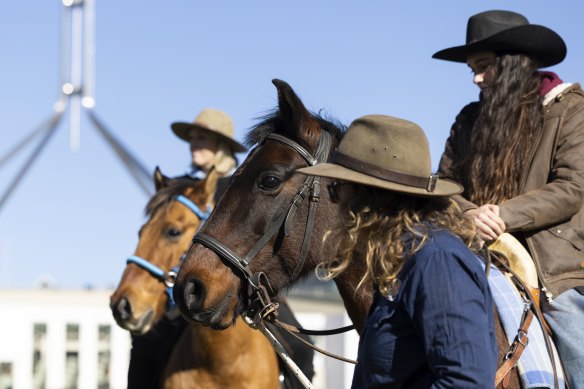
Victoria has a long-term strategy to reduce the number of horses in Barmah to zero, but in remote parts of the Victorian Alps, feral horses are so well established that Parks Victoria says it is unlikely they will ever be fully eradicated.
In the Blue Mountains and other parts of the Warragamba catchment, west of Sydney, a NSW National Parks and Wildlife Service spokesperson said, this year’s spring control program included aerial shooting of 93 of an estimated 100 horses, as well as 463 pigs, 72 goats, 48 deer and one fox.
The NSW government is also seeking to eradicate feral horses in the World Heritage-listed Barrington Tops, the mountainous area between the Hunter Valley and the Mid North Coast, as part of what it says is the state’s biggest yet feral animal control program.
NSW Environment Minister Penny Sharpe said invasive species, including horses, cost the state’s economy more than $1.9 billion a year.
“Wild horses in Barrington Tops and Warragamba catchment were ignored for more than 20 years, but our government will continue to remove them in accordance with the highest animal welfare standards,” Sharpe said.
Since January, NPWS has killed 662 invasive animals in Barrington Tops, including horses, pigs, rabbits and hares. A spokesperson said the pests were damaging fragile sub-alpine areas and degrading habitats for endangered species such as the broad-toothed rat and rare orchids, as well as endangering the public by wandering into campgrounds and popular walking areas.

A rally calling for brumbies to be rehomed as a priority method of management outside Parliament House.Credit: Alex Ellinghausen
NPWS said about 160 feral horses remained in Barrington Tops. If there is sufficient interest, then the service will trap horses for rehoming in 2025 before reducing the population to zero.
In Kosciuszko, the government is bound by legislation passed by the former government to preserve a brumby population. NPWS is required to reduce horse numbers to 3000 – but no lower – by 2027 in retention areas, and can aim for zero elsewhere in the park.
The November 2023 survey, using trained observers on helicopters, estimated more than 17,000 feral horses in Kosciuszko, an increase from about 6000 in 2014. In the past year, NPWS removed 6393 horses from the park, more than 90 per cent by aerial shooting.
Loading
The upper house inquiry, which had dissenting sections from the Animal Justice Party and the Nationals, found aerial shooting should continue alongside rehoming, and NPWS should investigate fertility control.
A Parks Victoria spokesman said the agency had launched a strategic action plan in 2020 for Barmah National Park after feral animals including horses and deer caused widespread ecological damage. The plan, developed with widespread consultation, aims to eradicate feral horses from the park and had been “largely successful”, he said.
The spokesman said horses in particular caused “large-scale and long-lasting” damage by trampling vegetation, distributing weeds and damaging fragile soils, and the destruction caused by feral animals was exacerbated by accelerated impacts of climate change.









 Add Category
Add Category